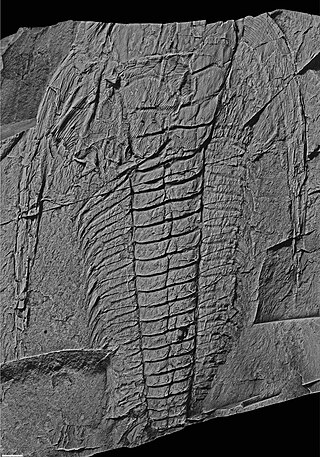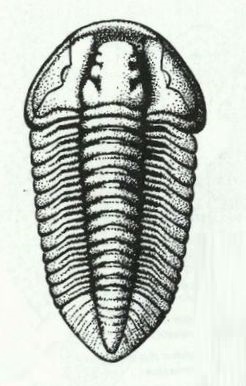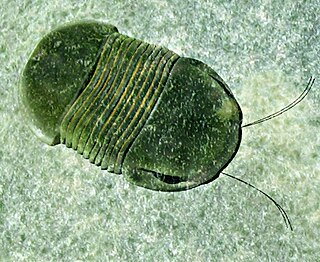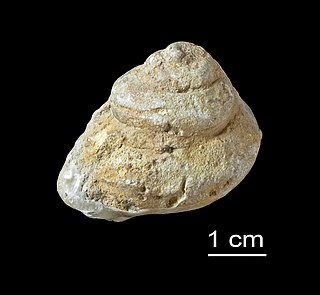
John William Salter was an English naturalist, geologist, and palaeontologist.

Flexicalymene Shirley, 1936. is a genus of trilobites belonging to the order Phacopida, suborder Calymenina and Family Calymenidae. Flexicalymene specimens can be mistaken for Calymene, Gravicalymene, Diacalymene and a few other Calymenina genera. They are used as an index fossil in the Ordovician. Ohio and North America are particularly known for being rich with Flexicalymene fossils.

Gravicalymene Shirley, 1936, is a genus of trilobites belonging to the order Phacopida, suborder Calymenina and family Calymenidae. Species included in this genus have previously been allocated to Calymene Brongniart 1822,Flexicalymene Shirley, 1936. and Sthenarocalymene Siveter 1977.

Diacalymene is a genus of trilobite from the order Phacopida, suborder Calymenina. It includes the species D. ouzregui, D. clavicula, D. diademata and D. gabrielsi. It lived in the Ordovician and Silurian periods.

Atrypa is a genus of brachiopod with round to short egg-shaped shells covered with many fine radial ridges. Growth lines form perpendicular to the costae and are spaced approximately 2 to 3 times further apart than the costae.. The pedunculate valve is slightly convex, but oftentimes levels out or becomes slightly concave toward the anterior margin. The brachial valve is highly convex. Neither valve contains an interarea. Atrypa had a large geographic range and occurred from the late Lower Silurian (Telychian) to the early Upper Devonian (Frasnian). Other sources expand the range from the Late Ordovician to Carboniferous, approximately from 449 to 336 Ma. A proposed new species, A. harrisi, was found in the trilobite-rich Floresta Formation in Boyacá, Colombia.

Cyphaspis is a genus of small trilobite that lived from the Late Ordovician to the Late Devonian. Fossils have been found in marine strata in what is now Europe, Africa and North America. Various species had a compact body, and a large, bulbous glabellum. Many species had long spines arranged similarly to closely related genera, such as Otarian, Otarionella, Chamaeleoaspis, and Namuropyge.
Anchiopsis is a genus of trilobite in the order Phacopida, which existed in what is now New York, U.S.A. It was described by Delo in 1935, and the type species is Anchiopsis anchiops, which was originally described as Calymene anchiops by Green in 1832.
Tarijactinoides is a genus of trilobites in the order Phacopida, which existed in what is now Bolivia. It was described by Suárez Soruco in 1971, and the type species is Tarijactinoides jarcasensis.

Dipleura is a genus of trilobites in the order Phacopida. It was described by Green in 1832, and the type species is Dipleura dekayi. The type locality was in the Hamilton Group in New York.

Homalonotus is an extinct genus of trilobites in the order Phacopida. It contains several species, including H. armatus and H. roemeri. It is closely related to other trilobites such as Arduennella and Dipleura..

Platyceras is a genus of extinct Paleozoic sea snails, marine gastropod mollusks in the family Platyceratidae. This genus is known from the Silurian to the Middle Triassic periods and especially abundant in the Devonian and Carboniferous. It is the type genus of the family Platyceratidae.

Marrellomorpha are an extinct group of arthropods known from the Cambrian to the Early Devonian. They lacked mineralised hard parts, so are only known from areas of exceptional preservation, limiting their fossil distribution. The best known member is Marrella, with thousands of specimens found in the Cambrian aged Burgess Shale of Canada. The group is divided up into two major orders, Marrellida and Acercostraca. Marrellida is recognised by the possession of head shields with two or three pairs of elongate spine-like projections, and three pairs of uniramous appendages on the cephalon, while Acercostraca generally have large ovoid carapaces that cover the entire upper half of the body, and five pairs of uniramous cephalic appendages. Both groups have unbranched antennules and a segmented trunk with biramous appendages. Recent research has suggested the previously enigmatic Cambrian trilobite-like arthropods Skania and Primicaris belong to this group. Their phylogenetic position is uncertain, various studies have alternatively placed them in the Arachnomorpha as relatives of Artiopoda, as related to Mandibulata, or as stem group euarthropods. Some authors have proposed that they may be closely related to sea spiders (Pycnogonida) within Chelicerata though the cladistical support for such a relationship is relatively weak.

Aulacopleura is a genus of proetid trilobite that lived from the Middle Ordovician to the Middle Devonian. Some authors may classify this group as subgenus Otarion (Aulacopleura). The cephalon is semicircular or semielliptical, with border and preglabellar field. The glabella is short, with or without defined eye ridges connecting it with eyes of variable size. Spines at the rear outer corners of the cephalon are present, typically reaching back to the 2nd to 4th thorax segment. The 'palate' is not connected to the dorsal shield of the cephalon. The cephalon is pitted, or has small tubercles. The thorax has up to 22 segments. The pleural ends are usually rounded. The pygidium is small (micropygous), with an even margin. A. koninckii had a modern type of compound eye.
Cordania is an extinct genus of trilobites that lived from the Early to Middle Devonian.

Bumastus is an extinct genus of corynexochid trilobites which existed from the Early Ordovician period to the Late Silurian period. They were relatively large trilobites, reaching a length of 6 in (15 cm). They were distinctive for their highly globular, smooth-surfaced exoskeleton. They possessed well-developed, large compound eyes and were believed to have dwelled in shallow-water sediments in life.

Pleurodictyum is an extinct genus of tabulate corals, characterized by polygonal corallites. Colonies commonly encrust hard substrates such as rocks, shells and carbonate hardgrounds.

Holopea is an extinct genus of fossil sea snails, Paleozoic gastropod mollusks in the family Holopeidae.
Angochitina is an extinct genus of chitinozoans. It was described by Alfred Eisenack in 1931.

Eusarcana is a genus of eurypterid, an extinct group of aquatic arthropods. Fossils of Eusarcana have been discovered in deposits ranging in age from the Early Silurian to the Early Devonian. Classified as part of the family Carcinosomatidae, the genus contains three species, E. acrocephalus, E. obesus and E. scorpionis, from the Silurian-Devonian of Scotland, the Czech Republic and the United States respectively.
Dudleyaspis is an extinct genus of Lower to Middle Devonian odontopleurid trilobites that lived in a shallow sea that lay between Euramerica and Gondwana. It was named in 1949 by Prantl & Pribyl.















